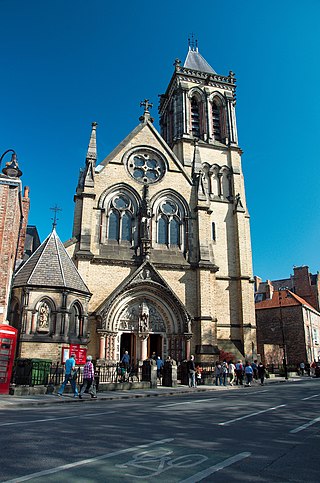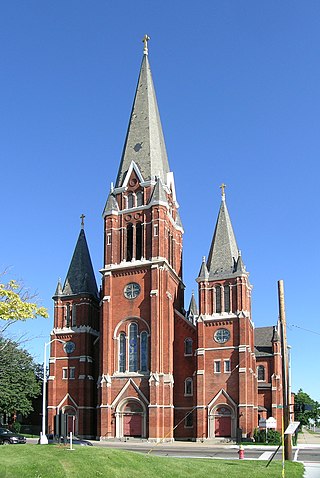
The Cathedral and Metropolitical Church of Saint Peter in York, commonly known as York Minster, is an Anglican cathedral in York, North Yorkshire, England, and is one of the largest of its kind in Northern Europe. The minster is the seat of the Archbishop of York, the third-highest office of the Church of England, and is the mother church for the Diocese of York and the Province of York. It is administered by its Dean and chapter. The title "minster" is attributed to churches established in the Anglo-Saxon period as missionary teaching churches, and serves now as an honorific title; the word Metropolitical in the formal name refers to the Archbishop of York's role as the Metropolitan bishop of the Province of York. Services in the minster are sometimes regarded as on the High Church or Anglo-Catholic end of the Anglican continuum.

West Norwood is a largely residential area of south London within the London Borough of Lambeth, located 5.4 miles (8.7 km) south south-east of Charing Cross. The centre of West Norwood sits in a bowl surrounded by hillsides on its east, west and south sides. From many parts of the area, distant views can be seen, of places such as the City of London, Canary Wharf and Crystal Palace.

The Oratory Church of Saint Wilfrid, York is a Catholic church in York, England.
York had around 45 parish churches in 1300. Twenty survive, in whole or in part, a number surpassed in England only by Norwich, and 12 are used for worship. This article consists of a list of medieval churches which still exist in whole or in part, and a list of medieval churches which are known to have existed in the past but have been completely demolished.

Southminster is a village and civil parish on the Dengie Peninsula in the Maldon district of Essex in the East of England. It lies about 3 miles (4.8 km) north of Burnham-on-Crouch and 10 miles (16 km) south-east of Maldon; it is approximately 52 miles (84 km) east-north-east of London. To the north is the River Blackwater, which is tidal, and, since Roman times, has been the gateway to trading in the area.

The Main Street Historic District encompasses the historic commercial center of Middletown, Connecticut, United States. Middletown was one of the most important ports on the Connecticut River during the colonial period, and Main Street "has been the center of community life since the earliest period of settlement". Today Main Street is home to a number of 19th century buildings, maintaining the bulk of its historic character. It was listed on the National Register of Historic Places in 1983.

Leeds Minster, or the Minster and Parish Church of Saint Peter-at-Leeds is the minster church of Leeds, West Yorkshire, England. It stands on the site of the oldest church in the city and is of architectural and liturgical significance. A church is recorded on the site as early as the 7th century, although the present structure is a Gothic Revival one, designed by Robert Dennis Chantrell and completed in 1841. It is dedicated to Saint Peter and was the Parish Church of Leeds before receiving the honorific title of "Minster" in 2012. It has been designated a Grade I listed building by Historic England.

J. W. Walker & Sons Ltd is a British firm of organ builders established in 1828 by Joseph William Walker in London. Walker organs were popular additions to churches during the Gothic Revival era of church building and restoration in Victorian Britain, and instruments built by Walker are found in many churches around the UK and in other countries. The firm continues to build organs today.

St. Josaphat Roman Catholic Church is a Roman Catholic church located at 715 East Canfield Street in Detroit, Michigan. It was listed on the National Register of Historic Places in 1982 and designated a Michigan State Historic Site in 1985. Since 2013, it has been one of two churches that comprise Mother of Divine Mercy Parish.

The Minster Church of St Andrew, also known as St Andrew's Church, Plymouth is an Anglican church in Plymouth. It is the original parish church of Sutton, one of the three towns which were later combined to form the city of Plymouth. The church is the largest parish church in the historic county of Devon and was built in the mid to late 15th century. The church was heavily damaged during the Plymouth Blitz but was rebuilt after the war. It was designated as a Minster Church in 2009 and it continues to operate as the focus for religious civic events for the city and as a bustling evangelical church.

Blake Street is a road in the city centre of York, in England.

Walmgate is a street in the city centre of York, in England. During the Medieval period, the street was the site of a seafish and cattle market. Walmgate Bar was involved in the Siege of York in 1644, during the First English Civil War. During the 20th century, many of the older buildings were cleared away and newer structures put up.

St Leonard's Place is a street in the city centre of York, in England.

Museum Street is a road in the city centre of York, in England.

Petergate is a street in the city centre of York, in England. It is divided into High Petergate and Low Petergate. The well-known view of the Minster from Low Petergate is described by the City of York Council as "excellent".

Ogleforth is a street in the city centre of York, in England.

Grape Lane is a street in the city centre of York, in England.

Minster Yard is a street in the city centre of York, England. It runs along the southern, eastern and northeastern sides of York Minster, for which it is named.

The Minster Close or Minster Precinct is the area surrounding York Minster. It first appeared in records from the late 13th century, when a wall was constructed around it.

Chapter House Street is a street in the city centre of York, England, connecting Ogleforth and Minster Yard.





















